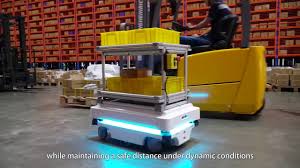Source: therobotreport.com
The Robot Report spoke with the following executives at robotics and artificial intelligence companies about their observations of 2019’s trends, as well as their expectations for the new year:
Sudhir Jha, senior vice president and head of Brighterion Inc., a Mastercard company that uses artificial intelligence and machine learning to provide mission-critical business intelligence in real time, regardless of type, complexity, or volume
Max Versace, co-founder and CEO of Neurala Inc., whose Brain Builder software platform applies AI to visual inspections
Thomas Visti, CEO of Mobile Industrial Robots ApS, which makes collaborative autonomous mobile robots (AMRs)
Which technologies do you expect to mature the most in 2020, such as the Industrial Internet of Things (IIoT), edge computing, 5G wireless networks, or autonomous vehicles?
Visti: In 2020, Industry 4.0 will become more of a reality than a vision. Smart machines keep getting smarter as they get access to more data, and they keep getting better at connecting to other machines and systems, and therefore they become truly useful for manufacturers.
While many companies have been hesitant and seen Industry 4.0 as merely a buzzword, we’re starting to see connected supply chains where MES [manufacturing execution systems], robots, and picking systems are connected.
We also see the connectivity between robots and ERP [enterprise resource planning] systems within production environments.
The entire process — from ordering to producing and then transporting goods — can now be fully automated. Industry 4.0 is still evolving, and it will not reach its full potential in 2020, but we will see more companies adopting the enabling technologies. This will also influence the workforce, as we will see the same companies wanting to upskill their current workforce and recruit new employees with Industry 4.0 skills.
Versace: We’ll see more demand for AI that can be trained, deployed, and refined at the edge. 2019 has shown us that many organizations, robotics companies included, are saying “No” to giving up their data and having to ping the cloud.
I believe that in 2020, AI will need to live and learn at the edge, so that processing occurs where the data is being generated. As a result, robotics companies will see reduced latency problems while mitigating privacy issues and massive cloud fees for manufacturers.
Jha: Enterprises will transition into deploying complex AI models in production at scale. So far, most AI applications are experiments but not in production, simple recommendation/prediction/regression models, or applied to smaller problems.
In 2020, we will see more enterprises getting bolder with their AI ambitions and requiring their vendors to support large deployments.
There will be be an acceleration from automation to autonomy, and AI will play the most crucial role in this. Also, robotics will move further from industrial arena to consumer arena, where they will act as personal coaches, instructors for children, conversational buddies for elders, and guides for the disabled.
Which market or application represents the biggest area of growth potential in 2020?
Visti: We expect to see an increase in the use of robotics in all our existing markets such as automotive, electronics, FMCG [fast-moving consumer goods], pharmaceuticals, and more.
There is still a huge focus on optimization, and with the lack of qualified workers, the need for automation across industries has never been higher.
We expect big growth in the use of AMRs by the 3PL [third-party logistics] segment, which has not been an early adopter of AMRs. In fact, our recent survey showed that only around 50% of 3PLs are currently considering automating internal logistics with AMRs. We expect to see this figure increase significantly in 2020 and the years ahead.
The hospital sector is also looking to automate internal transportation worldwide. For MiR, we have many customers within this segment in Scandinavia and China, but we expect it to grow even more.
Jha: Verticals like healthcare will see expanded AI-based applications, not only in the areas of diagnosis and personalized medicine, but also on the operational side like customer service, payment processing, and FWA (fraud, waste, and abuse).
How will trade conflicts or the slowdown in automotive manufacturing affect robotics in 2020?
Visti: While the automotive manufacturing market may have slowed, the latest statistics from the Robotic Industries Association actually shows what looks like an uptick in ordering of industrial robots by automotive OEMs, up 47% for 2019 over 2018.
We’re also experiencing increased growth in that market and overall, with companies like Toyota and Ford purchasing fleets of our AMRs.
We expect this is due to these manufacturers realizing how automation can help fill difficult-to-fill jobs; increase overall productivity; and enable humans to focus on higher-skilled, higher-quality, and higher-paid tasks. These are all benefits that can lead to growth and new job opportunities, which could help turn the automotive industry back around.
Versace: We will always be faced with some degree of socioeconomic uncertainty around the world. In terms of manufacturing, possible decoupling of Chinese and Western economies may actually bolster manufacturing in the U.S. and make it less reliant on overseas production in the long run. This may indirectly boost robotic deployments in the U.S. and Europe.
But at Neurala, we’re focused on what we can control, which is first and foremost to provide robotics and other companies with an AI platform that they can apply to solve real-world challenges. Our Brain Builder platform is helping organizations accelerate the process of building, deploying, and analyzing AI so they can focus on improving visual inspections.
What challenges and opportunities do you expect for AI in 2020?
Jha: As AI-based solutions become more mainstream across industries, we need to carve out a handful domain where our technology provides sustainable differentiation and allows us to be a leader.
We have focused on risk and compliance areas in financial services and are looking to diversify in other verticals. Also our strength in building mission-critical applications in highly regulated industries will serve us well to ensure data privacy and ethical use of AI which is a growing trend globally.
Versace: I’m thinking of 2020 as the “Year of Productization and the Customer.”
At Neurala, we’ll continue to work with customers so that they can independently build and deploy custom AI applications for the real world.
Furthermore, AI products such as Brain Builder will enable customers with little or no expertise in AI to build an end-to-end application from scratch, on their proprietary data. This means that enterprises will no longer be restricted by their size or resources when it comes to implementing AI as a part of their business strategies.


